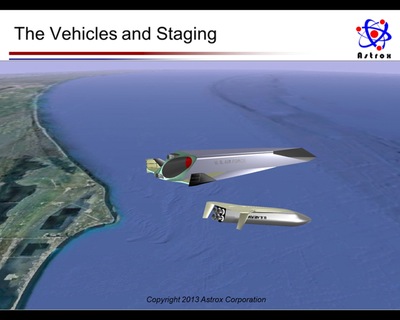Robust and reusable?by Ajay P. Kothari
|
| Of course, “space tourism” is just a means to an end: to have a self-sustaining chain that can keep these prices low. And if they can be kept low, many other business ideas would come into being. |
Let me say at the outset that my numbers below should be taken with some grains of salt, that they cannot be anything other than approximate, and that if anyone purportedly swears to present exact numbers, one should be suspicious to the hilt! So with that caveat, do also realize that we are talking about orders of magnitude at this time in history, and they do definitely help point to a direction we should take. This I can definitively state and defend.
A few years back we were asked to design and compare the weights, empty weights, and cost for eight options for the same payload to 100x100 nautical mile (185x185 kilometer) easterly LEO from the Kennedy Space Center. They all were two-stage-to-orbit (TSTO) designs. One of the eight was the expendable option, similar to what exists today. One was hybrid rocket (reusable first stage with an expendable upper stage—sort of a halfway point to fully reusable). The other six were all fully reusable. Four of the eight were vertical takeoff and four were horizontal takeoff. Five of them also included some form of airbreathing propulsion. These options, to scale, are shown below.
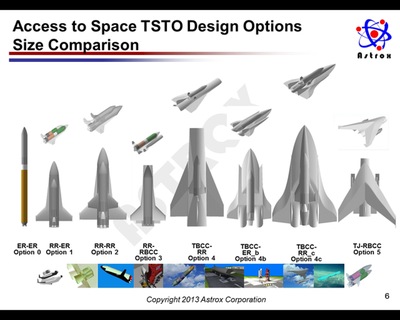 |
With these options as desired starting points, calculations were made and the vehicles designed. The following figure delineates the results of the designs. We used our code HySIDE to do all the designs and Tanscost 7.2 to do the cost estimates.
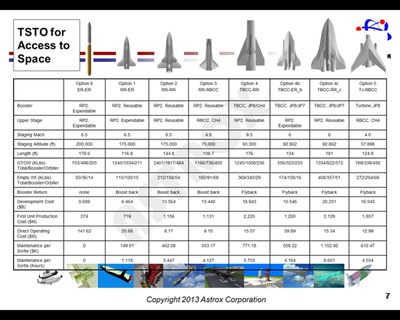 |
When we looked at and analyzed the cost numbers, it was obvious that a huge part of cost per pound came from the acquisition part, the FUPC (First Unit Production Cost) when they were expended outright, as in Options 0 and 1. But if reused, the Direct Operating Costs went down considerably. This can be expected, but it is good to have quantitative corroboration. Fuel and maintenance are minute compared to this. Of course, as we get more reusable, their percentage grows because the other one decreases considerably—rather obviously—but the total cost per pound to space can decline substantially. This is the only possible way to reduce the cost substantially, and is what we need to take advantage of.
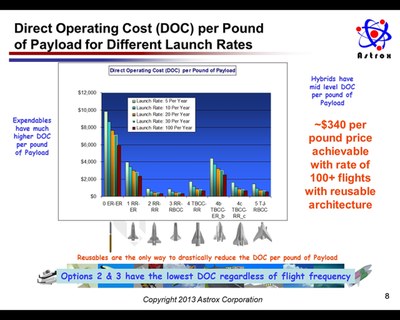 |
It is obvious from the figure above that Option 2 & 3 provided the best numbers: about $340 per pound to LEO for 100 flights or more, which translated to about $250,000–500,000 per ticket, inclusive of the cost to orbit and some stay there. Of course, “space tourism” is just a means to an end: to have a self-sustaining chain that can keep these prices low. And if they can be kept low, many other business ideas would come into being that are mentioned towards the end.
The next level of curiosity came from some what ifs. What if such attractive costs were applied to the study done by Futron in the early 2000s to assess the orbital space tourism market, instead of the millions of dollars per seat used in the original study?
| SpaceX numbers are two to four times more optimistic than ours, and we hope they can be reached, but even if they are not reached exactly, a business case can be made. |
Based on the survey, two price points of 1.5% and 5% of an individual’s net worth were used as bracketing points that these “high net worth” individuals would feel comfortable spending on such adventure. These, combined with the above two ticket prices of $250,000 and $500,000, gave four potential bracket points of a quadrilateral that the potential would reside in. Of the four permutations, one did not close as a business case but the other three did.
With the lower prices, the pool of the individuals whose net worth is such that 1.5% or 5% of it would equal the two ticket prices enlarges considerably in number. The figure given below is of the wealth distribution of individuals around the world plotted on a log-log scale where it is almost a straight line. This is the key. It is a log-log diagram.
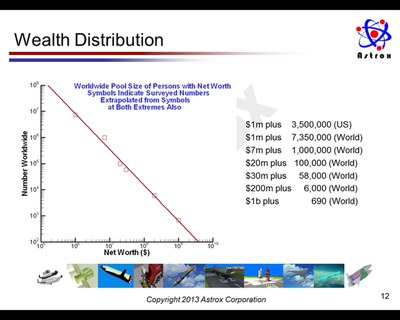 |
Of course not all such potential customers would care to go. So, to this potential pool, the willingness to go quotient is multiplied to estimate the number that may take it on.
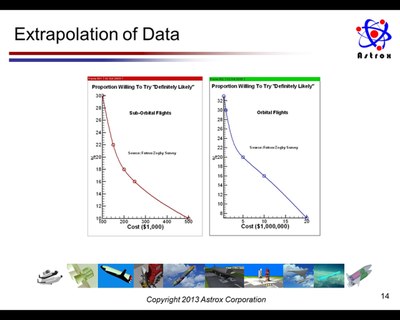 |
Finally, a 20-year S-curve was computed to forecast next several decades worth of business.
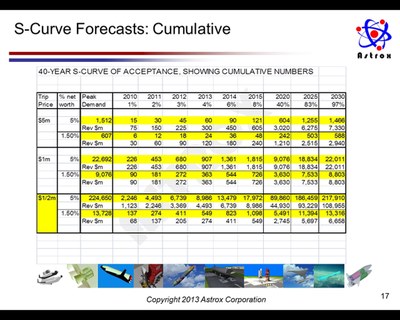 |
So our theoretical conclusions with some numbers to back them up are that something revolutionary can be possible, if done right. Whether they can actually be realized is unknown, but we may come very close to them. We never will come close if we do not go completely reusable—robust with quick turnaround.
- Demand of around 14,000 passengers for orbital space tourism at $500,000 price for 1.5% threshold
- Global revenues of $7 billion by 2030; equals 17 flights per year averaged: business case does not close
- Demand of around 225,000 passengers for orbital space tourism at $500,000 price for 5% threshold
- Global revenues of $109 billion by 2030; equals 280 flights per year averaged: business case closes
- Demand at $250,000 price for orbital space tourism:
- at 1.5% threshold of around 50,000 passengers and revenue of $12 billion; equals 62 flights per year averaged: business case almost closes
- 5% threshold of around 800,000 passengers and revenue of $200 billion; equals 1,000 flights per year averaged: business case closes very comfortably
- A global pool of customers is key to demand potential
- The pools mentioned herein will grow with time
- New people will join the pool
- Some will want to take multiple flights as one person has done so far even at the current extremely high price
So now, to philosophize further and to extrapolate to the populace at large: is there anything that we in the technology community in the US can do that would (a) help our economy prosper a bit more over a long term, (b) help with the economic edge we may have with the rest of the world, (c) maintain and improve upon the technological edge we have with the rest of the world in space and aeronautics, (d) be dual use enough that it can help us on the military side, and (e) maintain, retain, and sharpen the technological minds of this smart citizenry of the USA—the so-called “rocket scientists”?
Such a thing does exist, but a case for it has not been made because it was not possible to make it, so far. Now it can be. Such a thing is called a fully reusable, quick turn-around rocket and hypersonic vehicle architecture.
Both SpaceX and Orbital Sciences have sent capsules to ISS and SpaceX, of course, is continuing the Grasshopper program for the reusable first stage. Harvard Business Review published in their January-February 2012 edition “A List of Audacious Ideas for Solving the World’s Problems,” an article suggesting NASA find ways to reduce the cost of access to space. There is commonality of path in all of these arguments. Such a scenario can be realized if NASA expends its immense talents to develop the technologies required for fully reusable, quick turnaround rockets and hypersonic vehicles.
This is the missing link. It may do for space transportation what jet engines did for air transportation sixty years ago when people never imagined that more than 500 million passengers would travel by airplanes every year and that the cost could be reduced to the level it is—all because of passenger volume and reliable reusability. Space tourism may never achieve a million passengers per day but tens of thousands per year seems within reach if we do this right. Today the number is about one per year at a price of $30–60 million per ticket, and it may always rest there! At those prices, a high-volume closed business case was not possible to make with a straight face. Now it can be. A few years back, eight launch options using fully reusable systems for orbital access were designed and cost estimated by us at the behest of the Air Force. As depicted in the figure, two of them, options 2 (RR-RR) and 3 (RR-RBCC) were discovered to be the most promising and can lower the cost of a pound of payload to orbit to about $340 from $8,000–10,000 per pound currently.
Both options require a reusable rocket as the first stage. The second stage subsequently reenters and lands just as the space shuttle did. Such a hypersonic plane would use highly promising scramjet propulsion judiciously combined with rocket propulsion which can also become available for military applications.
| Development of such a capability by NASA, preferably in cooperation with the Defense Department, is a necessary condition, and hence a must. |
All this if we can design the vehicles and rockets to last for at least 200 flights safely—a technologically possible feat. It can combine to reduce the space tourism ticket price to about $500,000 or even $250,000. The Futron study showed that this will increase the worldwide potential customer base from a few today to a total of 50,000 to 800,000 with averaged revenues from $0.6 to $10 billion per year—surely a business case that investors can see a potential in. That is where NASA comes into the picture. NASA should divert some of its funds—perhaps three to five percent of its budget—for starting its own blend of mini-Manhattan and mini-National Highway System projects to develop fully reusable technologies for the vehicle and the propulsion systems. Such a vehicle would have military applications as well, justifying the Defense Department and NASA working together on its development. While the ticket price points used here would still be out of reach for most of us, this paradigm will create tens of thousands of technology jobs, and with time and experience, those prices can further decline. To their credit, some at NASA and the Defense Department have also sided with the fully reusable approach, but recently NASA cancelled their hypersonic program.
However, space tourism as a potential business that can help the US economy is only part of the equation, and surely not a strong enough reason to change the paradigm on its own. What else would it do for the country?
It can open up a multitude of avenues. It will enable point-to-point hypersonic travel to transport us from here to East Asia in two to three hours using ramjet or scramjet propulsion. We can clean-up defunct satellites or service the ones in need of repair. More importantly, we can build much needed fuel depots in orbit, and the space entrepreneurs can supply them with 5,000 to 10,000 pounds of fuel at a time. It can build a waystation for future travels to the Moon or Mars requiring less fuel, as getting to orbit is about half the work (half the kinetic energy) of going to Mars. Businesses that were supposed to materialize by using the International Space Station, but did not due to very high cost of going to orbit, may do so also. It is not any one of the items mentioned above or any one of the prospective promises mentioned at the top—it is the ability of this idea to do all of them at the same time which is its merit.
One thing is for certain: a lack of such capability will wreck any chance of a fruitful realization of such businesses and hamper our national space goals. Development of such a capability by NASA, preferably in cooperation with the Defense Department, is a necessary condition, and hence a must.
